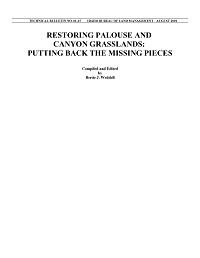Restoring Palouse and Canyon Grasslands: Putting Back the Missing Pieces

Prior to the middle of the nineteenth century, the natural vegetation of the Palouse region
of southeastern Washington, northeastern Oregon, and adjacent parts of northern Idaho was
dominated by steppe and meadow steppe plant associations. Beginning in the 1830s,
Euroamerican settlement of the region led to dramatic changes. Deep soils were cultivated, and
shallower soils were grazed by livestock. The extent and quality of native grasslands declined as
a result of these changes in land use. For this reason, there is now considerable interest in
restoring native vegetation in the Palouse region. This volume looks at the prospects for
restoration of native steppe and meadow steppe communities, with an emphasis on methods that
do not create areas of bare soil. Section 1 reviews work that has been done on the restoration of
native steppe and meadow steppe. Section 2 reports on the results of pilot projects undertaken to
(A) compare microbial soil communities in native and non-native vegetation at two meadow
steppe and two steppe sites, (B) test the efficacy of bacterial control of a severe cheatgrass
infestation, and (C) investigate the effectiveness of artificial ground covers on survival of
transplanted native grass plugs.
